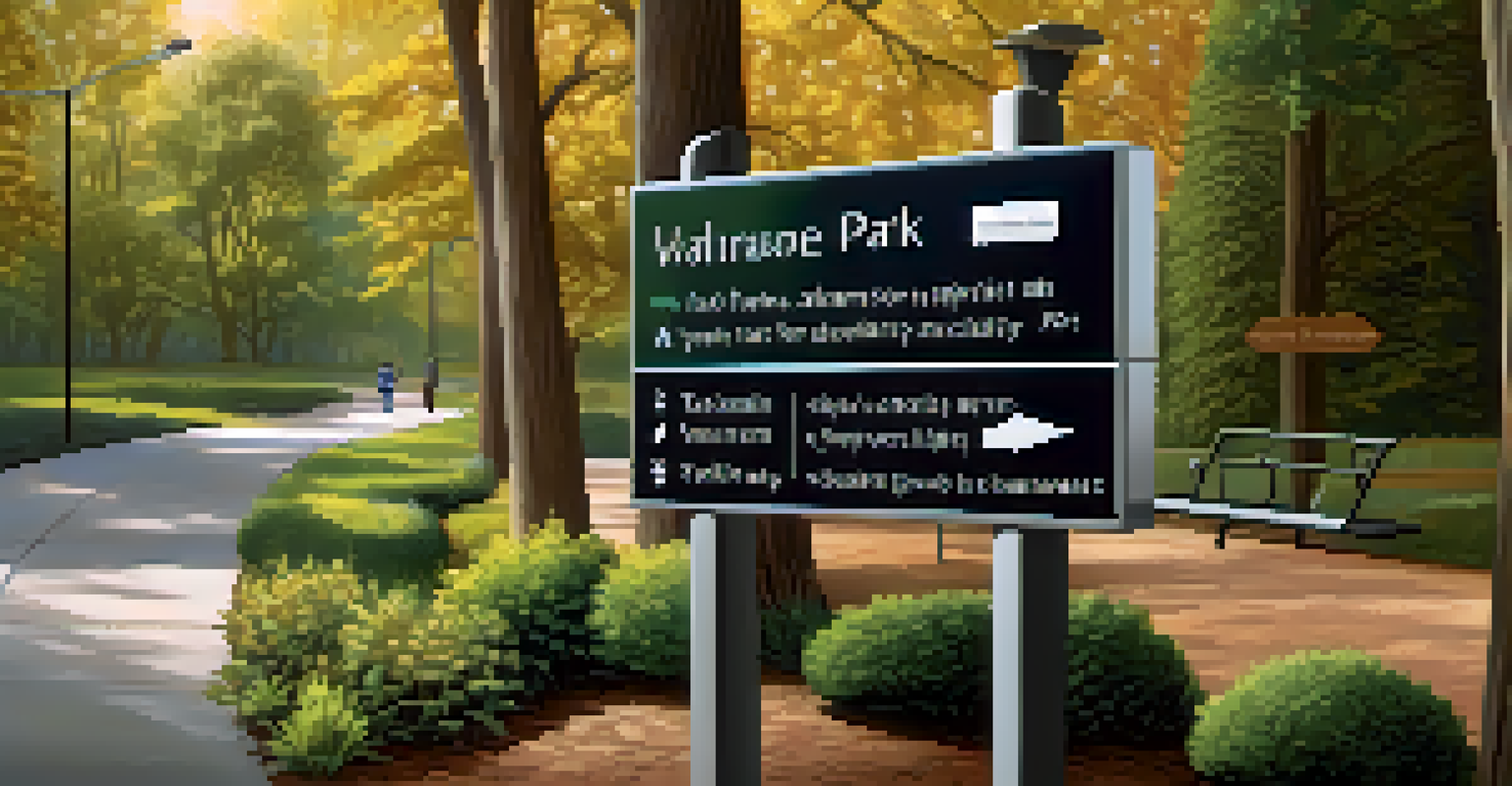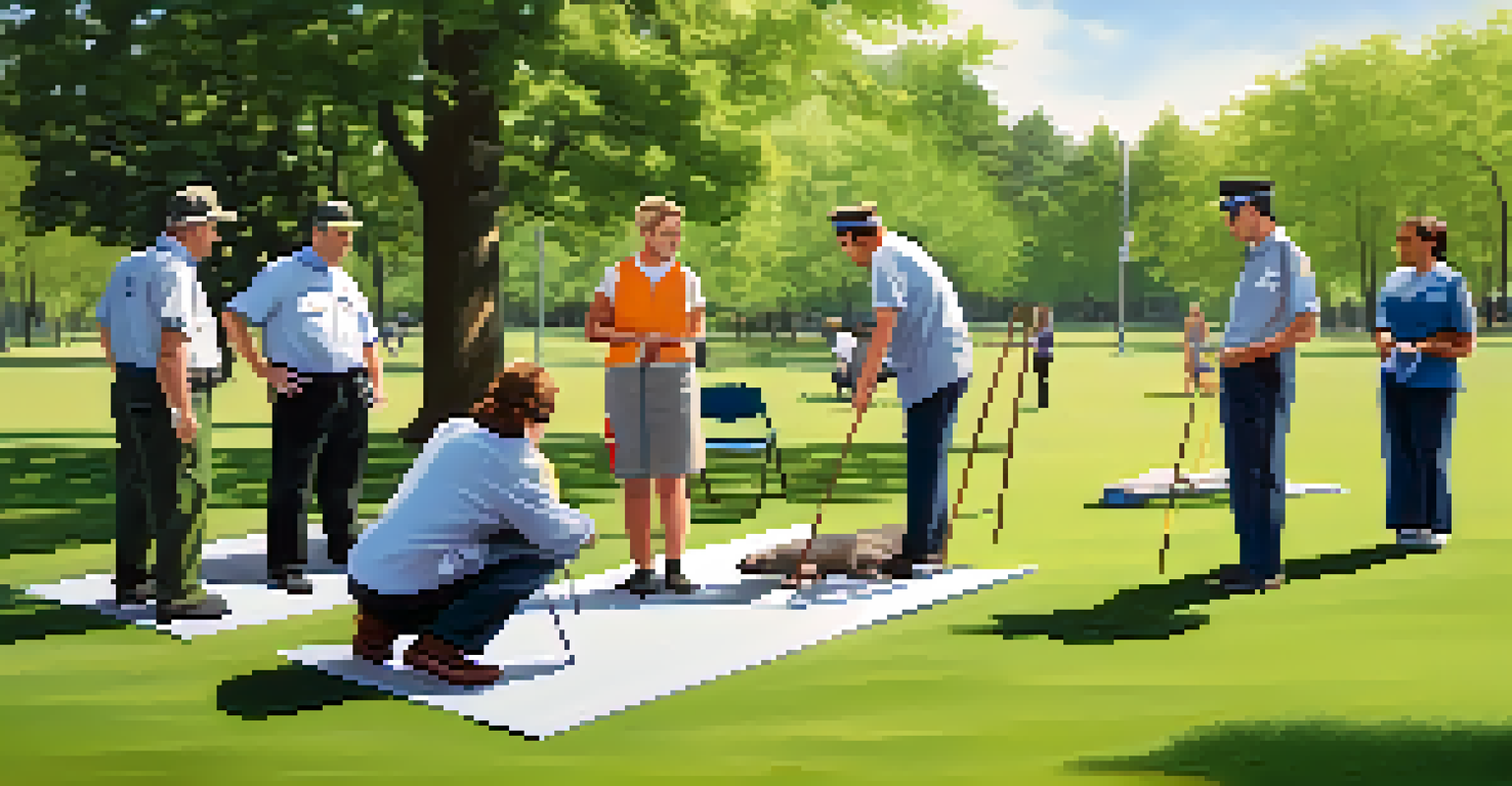Improving Pathway Navigation for Visually Impaired Park Users

Understanding the Challenges of Visually Impaired Navigation
Navigating public spaces can be daunting for visually impaired individuals. Parks, often filled with diverse terrains and obstacles, pose unique challenges that can hinder their enjoyment. The lack of clear pathways and tactile guidance can make it difficult for these users to explore and connect with nature safely.
The greatest gift of the garden is the restoration of the five senses.
In many cases, visually impaired park users rely on their other senses to navigate. Sounds from nature, the scent of flowers, and even changes in temperature can provide valuable clues about their surroundings. However, when pathways are poorly marked or obstructed, these sensory cues may be insufficient, leading to frustration and a sense of isolation.
To create a more inclusive environment, it's essential to understand the specific needs of visually impaired individuals. This empathy can drive the development of innovative solutions that enhance their experience and ensure they can fully enjoy the beauty and benefits of parks.
Incorporating Tactile Pathways into Park Design
Tactile pathways are designed to provide a physical guide for visually impaired users. These pathways can be created using textured materials that contrast with the surrounding ground, allowing users to feel their way through the park. By incorporating these elements into park design, we can significantly improve navigation and safety.

For example, using raised tactile paving can help delineate pathways from surrounding grass or dirt. This not only aids visually impaired users but also enhances the overall aesthetic of the park. The key is to ensure these pathways lead to essential park features, such as restrooms, benches, or viewing areas.
Enhancing Navigation for All
Implementing tactile pathways, audio cues, and technology can significantly improve navigation for visually impaired individuals in parks.
Moreover, tactile pathways can be complemented with audio cues, such as strategically placed sound beacons. These can emit sounds or verbal prompts to guide users along their route, making navigation even easier. Together, these elements create a more accessible park experience.
Utilizing Technology for Enhanced Navigation
Technology plays a pivotal role in improving navigation for visually impaired park users. Mobile applications equipped with GPS and voice guidance can help users identify their location and navigate through parks confidently. By integrating these technologies, parks can offer a modern solution to traditional navigation challenges.
Accessibility is not a privilege, it is a right.
For instance, apps can provide real-time updates on park conditions, such as trail closures or weather warnings. Additionally, features like virtual tours can familiarize users with the park layout before they even arrive. This proactive approach can empower visually impaired visitors to plan their visits with greater ease.
Moreover, wearable technology, such as smart glasses or haptic feedback devices, can further enhance the navigation experience. These devices can provide users with immediate feedback about their surroundings, ensuring they feel secure and informed as they explore the park.
Training Staff for Better Assistance
Park staff play a crucial role in fostering an inclusive environment for visually impaired visitors. By training staff on how to assist these individuals effectively, parks can create a welcoming atmosphere. This training can include understanding the needs of visually impaired users and learning how to provide appropriate guidance.
For example, staff can be taught to communicate clearly and offer their arm for guiding, which can help visually impaired individuals navigate safely. Additionally, staff should be aware of the park's layout and features, enabling them to provide accurate information to visitors. This knowledge can be invaluable in creating a seamless experience.
Training Staff for Inclusivity
Well-trained park staff can provide essential assistance and foster a welcoming environment for visually impaired visitors.
Moreover, regular workshops and training sessions can keep staff updated on new technologies and best practices. By continuously improving their skills, park staff can ensure that all visitors feel supported and valued, fostering a sense of community.
Implementing Clear Signage for All Users
Clear and accessible signage is vital for improving navigation in parks. Signage should be designed with simplicity in mind, using large fonts and high-contrast colors for better visibility. For visually impaired users, signs can also include Braille and tactile elements to facilitate understanding.
Additionally, placing signs at regular intervals along pathways can help users remain oriented. These signs should provide essential information, such as directions to facilities, park rules, and emergency contacts. By ensuring that signage is consistent throughout the park, we can enhance the overall navigation experience.
Furthermore, parks can incorporate digital signage that provides audio descriptions or information via smartphone apps. This multi-sensory approach ensures that everyone, regardless of their abilities, can access the information they need to enjoy the park.
Creating Community Engagement and Feedback Channels
Engaging with the community is key to understanding the needs of visually impaired park users. By establishing feedback channels, parks can gather valuable insights from visitors about their experiences and suggestions for improvement. This input can help shape future developments and ensure that parks remain inclusive.
For instance, hosting community events or focus groups can facilitate open discussions between park officials and visually impaired users. These interactions can provide firsthand accounts of the challenges faced and the solutions that could enhance their experience. By listening actively, parks can create a sense of ownership among users.
Community Engagement Matters
Establishing feedback channels and collaborating with local organizations can help parks understand and address the needs of visually impaired users.
Additionally, parks can collaborate with local organizations that support visually impaired individuals. These partnerships can lead to innovative programs, such as guided tours or accessibility workshops, further enriching the park experience for everyone.
Promoting Awareness and Education on Accessibility
Raising awareness about the needs of visually impaired individuals is essential for fostering an inclusive park environment. Educational campaigns can inform the public about the importance of accessibility and the benefits it brings to everyone. By promoting understanding, we can break down barriers and encourage more inclusive behavior.
For example, parks can organize workshops or seminars that highlight the experiences of visually impaired users. These events can showcase the technologies and adaptations that make parks more accessible, encouraging a culture of inclusivity. Engaging storytelling can play a significant role in driving empathy and understanding.

Moreover, social media and community outreach can be powerful tools for spreading awareness. By sharing success stories and highlighting ongoing efforts to improve accessibility, parks can inspire others to take action and contribute to a more inclusive society.